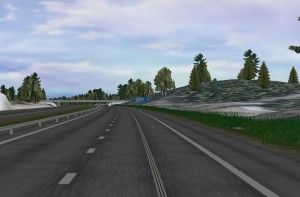In several years we will need to rely on something other than fossil fuels for our transport needs. One possible alternative is for our vehicles to run on electricity supplied along the road. In autumn 2014, VTI partnered with the Swedish Transport Administration and Viktoria Swedish ICT to test electrified roads in a driving simulator.

The simulated electric road between Gothenburg and Mölnlycke. The road environment has been supplemented with signs, guardrails, etc. The transmission poles are based on a design from Siemens.
There are several ways to transmit electricity to a vehicle while it is driving, i.e., via overhead lines, conductors in the roadway, or magnetic fields in the road (i.e., inductive transmission). These alternatives have different advantages and disadvantages in terms of capacity, safety, and aesthetics. In a driving simulator, it is possible to model different technical solutions and observe the interactions between infrastructure, vehicle, and driver.
“Simulators are perfect for studying systems and environments that are not yet available, as they are flexible, safe, and cost-effective. In this project we have created models of an electrified road, electric vehicles, and driver support systems”, says VTI project manager and researcher Arne Nåbo.
Intensive phase
In several seminars conducted last autumn, participants from the Swedish Transport Administration, Vattenfall, Scania, and Lund Technical University offered their views as to what studies could be of interest regarding electric roads and hybrid vehicles in a simulator environment. A user study in a driving simulator was conducted in October.
“We have a number of activities underway simultaneously: we’re evaluating the results of the user study and we’re also about to produce a three-minute informative film about the project. In addition, we’re working on building a smaller electric road simulator. It will be portable, and the idea is that it will be possible to bring it along for demonstrations outside of VTI”, says Nåbo.
User acceptance is key
A primary focus of the project is to find out what users think, which is a key to ensuring that the systems will ultimately be user-friendly and accepted.
“We have designed the virtual demonstration environment so that the test subjects in the simulator can experience what it would be like to drive on electrified roads, and so that we can study driver behaviour”, says Nåbo.
The user study was conducted in the SIM II simulator at VTI in Linköping. Twenty-six lorry drivers drove along the simulated road between Gothenburg and Borås two times each, i.e., with and without electrification. During the drive, they had to perform various tasks in order to increase their mental stress. The purpose of the study was in part to test driver ability to maintain a good position on the road, as that is important if electrical transmission is to function properly. The drivers also reported on their simulated experience of the road environment and safety conditions.
The road environment is changed
Another important part of the project was to study how road electrification could be realized in the road environment and what it might look like. Many different objects are present near the road, such as transmission poles, signs, and guardrails, as well as other installations such as transformer stations.

Simulated electric road at Hällered, where the electricity is transferred via a rail in the roadway.
“The simulator environment we will use for demonstrations will soon be ready. It will allow us to take account of all relevant transmission technologies: overhead lines, conductive transmission via the roadway, inductive transmission via the roadway, and a range of electric vehicles. It will be a richer driver environment than the one employed in the user study. We have also updated the vehicle model so that the lorry can now charge its batteries from the electric road”, says Nåbo.
Spreading the concept
The simulator is an excellent instrument to use in the transition from concept to market launch. Proposed concepts for products and services can be tested and demonstrated. These simulator activities stimulate the collaborative development of the electrification of vehicles and roads, which will make it possible to introduce high-quality systems early on.
“Demonstrations in simulators offer an excellent means of marketing new transportation solutions. In November and December we will be running demonstrations for financiers, actors, stakeholders, and the media so that they can experience and spread the concept”, says Nåbo.
The project was presented at a session on electric roads at the conference Transportforum in Linköping on 8 January 2015.
The project is being conducted under the auspices of the Swedish Energy Agency’s electric vehicle demonstration programme. The aim is to stimulate, support, and drive the collaborative development of vehicle and road electrification. Recipients of the results will include the group in the Forum for Innovation in the Transport Sector that is working on the “roadmap” for transport electrification. The project ends in January 2015.
Text: Eva Åström
 Contact: Contact:Arne Nåbo arne.nabo@vti.se VTI, Sweden |






Follow us: